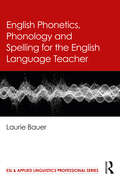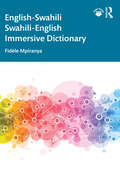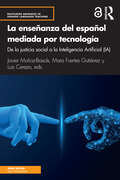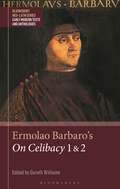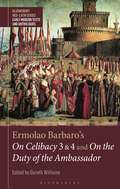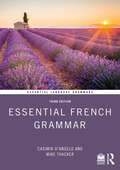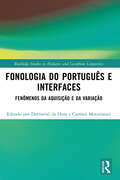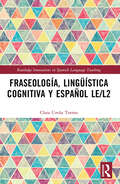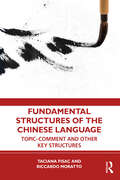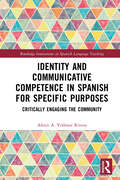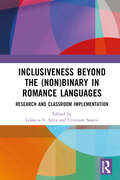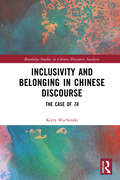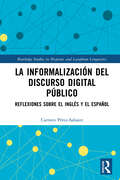- Table View
- List View
English Phonetics, Phonology and Spelling for the English Language Teacher (ESL & Applied Linguistics Professional Series)
by Laurie BauerThis resource supports TESOL preservice and in-service teachers and curriculum designers in teaching pronunciation more effectively. Laurie Bauer examines the patterns of pronunciation found in English, comments on common errors made by learners, provides advice on what must be taught and what can be allowed to pass, and offers commentary on which parts of the curriculum are necessary for beginners and which are of value only to advanced students. Part I introduces the phonetic background; Part II covers phonetics in more detail (consonants, vowels, prosody, phonotactics and syllables); Part III covers phonology (sound changes influenced by adjacent sounds, morphophonemics, stress rules and free variation); and Part IV covers spelling (English spelling, spelling consonants and vowels, and spelling particularly difficult words). The helpful content can be tailored to one’s teaching needs and will support an educator’s efforts to teach pronunciation seriously, whether it is a matter of pronouncing particular vowels accurately or knowing how to interpret the spelling system to get at the appropriate pronunciation.
English Phonetics, Phonology and Spelling for the English Language Teacher (ESL & Applied Linguistics Professional Series)
by Laurie BauerThis resource supports TESOL preservice and in-service teachers and curriculum designers in teaching pronunciation more effectively. Laurie Bauer examines the patterns of pronunciation found in English, comments on common errors made by learners, provides advice on what must be taught and what can be allowed to pass, and offers commentary on which parts of the curriculum are necessary for beginners and which are of value only to advanced students. Part I introduces the phonetic background; Part II covers phonetics in more detail (consonants, vowels, prosody, phonotactics and syllables); Part III covers phonology (sound changes influenced by adjacent sounds, morphophonemics, stress rules and free variation); and Part IV covers spelling (English spelling, spelling consonants and vowels, and spelling particularly difficult words). The helpful content can be tailored to one’s teaching needs and will support an educator’s efforts to teach pronunciation seriously, whether it is a matter of pronouncing particular vowels accurately or knowing how to interpret the spelling system to get at the appropriate pronunciation.
English-Swahili Swahili-English Immersive Dictionary
by Fidèle MpiranyaOrganized in an English-Swahili section and a Swahili-English section, English-Swahili Swahili-English Immersive Dictionary is a comprehensive presentation of Swahili usual lexicon. In both sections, entries are presented in clusters, based on the connections between the words of the target language (Swahili) in terms of meaning or origin. This meaning-driven presentation allows target language terms that are relatively similar in meaning, and therefore easily confused, as well as terms derived from the same base, to appear together in parallel contrastive lines. This creates an immersion effect that is particularly stimulating for language learning, since the user gets the opportunity to discover the words of the learned language group-by-group, rather than one-by-one, and is constantly reminded of subtle differences between different terms. It will help the learner master the vocabulary at a faster pace and with a better understanding of the rules that shape the lexicon of the target language. In addition, the introduction to the dictionary presents key grammatical points of Swahili that will help the reader make a productive use of information provided in the body of the dictionary. Additional grammatical information about the target language words such as the agreement pattern, the register of speech, or the level of use, is also provided in both sections to make it immediately accessible to the non-native user. The book is ideal for English-speaking learners of Swahili.
English-Swahili Swahili-English Immersive Dictionary
by Fidèle MpiranyaOrganized in an English-Swahili section and a Swahili-English section, English-Swahili Swahili-English Immersive Dictionary is a comprehensive presentation of Swahili usual lexicon. In both sections, entries are presented in clusters, based on the connections between the words of the target language (Swahili) in terms of meaning or origin. This meaning-driven presentation allows target language terms that are relatively similar in meaning, and therefore easily confused, as well as terms derived from the same base, to appear together in parallel contrastive lines. This creates an immersion effect that is particularly stimulating for language learning, since the user gets the opportunity to discover the words of the learned language group-by-group, rather than one-by-one, and is constantly reminded of subtle differences between different terms. It will help the learner master the vocabulary at a faster pace and with a better understanding of the rules that shape the lexicon of the target language. In addition, the introduction to the dictionary presents key grammatical points of Swahili that will help the reader make a productive use of information provided in the body of the dictionary. Additional grammatical information about the target language words such as the agreement pattern, the register of speech, or the level of use, is also provided in both sections to make it immediately accessible to the non-native user. The book is ideal for English-speaking learners of Swahili.
La enseñanza del español mediada por tecnología: de la justicia social a la Inteligencia Artificial (IA) (Routledge Advances in Spanish Language Teaching)
La enseñanza del español mediada por tecnología ofrece una nutrida panorámica de la investigación actual y de las estrategias didácticas sobre la integración de la tecnología en la enseñanza y el aprendizaje del español. Estructurado en trece capítulos esenciales, el libro constituye una hoja de ruta diseñada para que los profesionales de la lengua incorporen de manera eficaz la tecnología en cualquier entorno de aprendizaje: presencial, híbrido o en línea.Características principales: marco metodológico Planificar, Personalizar e Implementar (PPI) con elementos teóricos y prácticos sobre tecnología y enseñanza de lenguas selección de temas: accesibilidad, diseño curricular, actitudes de los docentes y diversidad; estrategias para gestionar la motivación, ansiedad, interacción y feedback; pautas para gestionar la enseñanza híbrida y en línea, inmersión lingüística digital, podcasts y narraciones digitales; gamificación e Inteligencia Artificial (IA) estructura consistente: conceptos clave, directrices metodológicas, consideraciones prácticas y referencias adicionales estrategias pedagógicas para apoyar la enseñanza de lenguas mediada por tecnología Escrito por un elenco internacional de investigadores, el libro es un recurso único para incorporar prácticas eficientes en la enseñanza de idiomas mediada por tecnología.La enseñanza del español mediada por tecnología offers a thorough exploration of current research and instructional strategies related to the integration of technology into the teaching and learning of Spanish. It consists of thirteen chapters that serve as a roadmap designed for language professionals to effectively incorporate technology into their learning environments: face-to-face, hybrid, or fully online.Key features: Three major sections presented as a framework, Planning, Personalizing and Implementing (PPI), that blend both theoretical and practical elements of technology; A unique range of topics, such as accessibility, curriculum development, teachers' beliefs and diversity; strategies for managing motivation, anxiety, interaction, and feedback; tips for effective hybrid and online teaching, digital language immersion, use of podcasts and digital storytelling, gamification, and Artificial Intelligence (AI); A consistent format for all chapters, with key concepts, methodological guidelines, practical considerations, and references for further exploration of each topic covered; Clear explanations and numerous scenarios that help readers comprehend the various factors that influence technology-assisted language learning; Support for educators in navigating the challenges that arise in technology-enhanced learning and teaching, with a focus on pedagogical best practices; Tips for educators to transition from a conventional curriculum approach to a more creative and engaging one that maximizes learning opportunities mediated by technology. Written by an international team of scholars, La enseñanza del español mediada por tecnología is a unique resource for Spanish language professionals at any context who wish to improve and enhance their teaching techniques. The book will be equally valuable to teachers of other languages as it contains relevant material on best practices and classroom management in technology-mediated education.
La enseñanza del español mediada por tecnología: de la justicia social a la Inteligencia Artificial (IA) (Routledge Advances in Spanish Language Teaching)
by Javier Muñoz-Basols Mara Fuertes Gutiérrez Luis CerezoLa enseñanza del español mediada por tecnología ofrece una nutrida panorámica de la investigación actual y de las estrategias didácticas sobre la integración de la tecnología en la enseñanza y el aprendizaje del español. Estructurado en trece capítulos esenciales, el libro constituye una hoja de ruta diseñada para que los profesionales de la lengua incorporen de manera eficaz la tecnología en cualquier entorno de aprendizaje: presencial, híbrido o en línea.Características principales: marco metodológico Planificar, Personalizar e Implementar (PPI) con elementos teóricos y prácticos sobre tecnología y enseñanza de lenguas selección de temas: accesibilidad, diseño curricular, actitudes de los docentes y diversidad; estrategias para gestionar la motivación, ansiedad, interacción y feedback; pautas para gestionar la enseñanza híbrida y en línea, inmersión lingüística digital, podcasts y narraciones digitales; gamificación e Inteligencia Artificial (IA) estructura consistente: conceptos clave, directrices metodológicas, consideraciones prácticas y referencias adicionales estrategias pedagógicas para apoyar la enseñanza de lenguas mediada por tecnología Escrito por un elenco internacional de investigadores, el libro es un recurso único para incorporar prácticas eficientes en la enseñanza de idiomas mediada por tecnología.La enseñanza del español mediada por tecnología offers a thorough exploration of current research and instructional strategies related to the integration of technology into the teaching and learning of Spanish. It consists of thirteen chapters that serve as a roadmap designed for language professionals to effectively incorporate technology into their learning environments: face-to-face, hybrid, or fully online.Key features: Three major sections presented as a framework, Planning, Personalizing and Implementing (PPI), that blend both theoretical and practical elements of technology; A unique range of topics, such as accessibility, curriculum development, teachers' beliefs and diversity; strategies for managing motivation, anxiety, interaction, and feedback; tips for effective hybrid and online teaching, digital language immersion, use of podcasts and digital storytelling, gamification, and Artificial Intelligence (AI); A consistent format for all chapters, with key concepts, methodological guidelines, practical considerations, and references for further exploration of each topic covered; Clear explanations and numerous scenarios that help readers comprehend the various factors that influence technology-assisted language learning; Support for educators in navigating the challenges that arise in technology-enhanced learning and teaching, with a focus on pedagogical best practices; Tips for educators to transition from a conventional curriculum approach to a more creative and engaging one that maximizes learning opportunities mediated by technology. Written by an international team of scholars, La enseñanza del español mediada por tecnología is a unique resource for Spanish language professionals at any context who wish to improve and enhance their teaching techniques. The book will be equally valuable to teachers of other languages as it contains relevant material on best practices and classroom management in technology-mediated education.
Ermolao Barbaro's On Celibacy 1 and 2 (Bloomsbury Neo-Latin Series: Early Modern Texts and Anthologies)
by Gareth WilliamsThis volume offers the first annotated English translation of the first two books of On Celibacy (1473) by the eminent Venetian humanist Ermolao Barbaro (1454-93); Books 3 and 4 of On Celibacy are presented, along with Barbaro's On the Duty of the Ambassador, in the companion piece to this first volume. Setting out the historical context that crucially conditions Barbaro's advocacy of the celibate life in Books 1 and 2, the introduction examines how On Celibacy seeks to justify a contemplative existence that rejects the career path expected of a figure of Barbaro's standing within the Venetian patrician class. Beyond setting out the essential facts of Ermolao Barbaro's life-story, Gareth Williams discusses how On Celibacy is set in counterpoise to the treatise On Marriage (1415) that was composed by Ermolao's eminent grandfather, Francesco Barbaro. If the latter's treatise was vitally concerned with the institution of marriage as a key factor in the safeguarding of family succession and the stability of patriciate participation in government at Venice, On Celibacy presents an alternative ideal whereby the celibate can proudly renounce civic life in the name of self-discovery and the pursuit of wisdom, his abilities simply unsuited to the rigors of civic life. On Celibacy is thus implicated in a much wider 15th-century debate about the claims of the contemplative as opposed to the active life – a debate that extends all the way back to Graeco-Roman antiquity.
Ermolao Barbaro's On Celibacy 3 and 4 and On the Duty of the Ambassador (Bloomsbury Neo-Latin Series: Early Modern Texts and Anthologies)
by Gareth WilliamsThis book offers the first annotated translation into English of two works of the eminent Venetian humanist, Ermolao Barbaro (1454–93). Books 3 and 4 of On Celibacy seek to justify a contemplative existence at a far remove from the active life and career-path expected of a figure of Barbaro's standing within the Venetian patriciate; Books 1 and 2 of On Celibacy are presented in the companion-piece to this second volume. The second work presented here is Barbaro's short treatise On the Duty of Ambassador (1488): based on Barbaro's own practical experience as a Venetian envoy abroad, this treatise outlines the conduct expected of the dedicated career diplomat. Viewed against each other, Barbaro's On Celibacy and On the Duty of the Ambassador offer contrasting perspectives on the wider 15th-century debate about the claims of the reflective as opposed to the active life – a debate that extends all the way back to Greco-Roman antiquity. In On Celibacy the young Barbaro is committed to a life that proudly renounces civic engagement in the name of self-discovery and inner fulfilment. Yet a different Barbaro asserts himself in On the Duty of the Ambassador: he now presents himself as a committed public servant in a work that is ahead if its time in theorizing the nature of 'modern' Renaissance diplomacy. On a personal level, these two works capture the profound dichotomy in Barbaro's life between his humanist devotion to scholarship on the one hand and, on the other, his call of duty to the Republic of Venice.
Essential French Grammar (Essential Language Grammars)
by Casimir d'Angelo Mike ThackerEssential French Grammar is a student-friendly French grammar designed to give learners a firm foundation on which to build a real understanding of both spoken and written French. Clear explanations of grammar are supported by contemporary examples, lively cartoon drawings, and a variety of exercises.Key features of the textbook include: each grammar point explained initially with reference to English parallels between English and French provided where relevant ‘Key points’ boxes and tables that summarize grammar concepts real-life language examples in French, with English translations a variety of exercises to reinforce learning a contemporary primary source or literary extract to illustrate grammar in context detailed coverage of punctuation, accents, spelling, and the specific sounds of French An introductory chapter describes the lexical and grammatical differences between French and English and a glossary of grammatical terms in French and English, useful verb tables, and an exercise key are also provided, making this an ideal resource for both independent and class-based learners. This third edition offers additional activities throughout, describes the much-debated practice of inclusive language in French and includes a brief history of the influence of French words on English vocabulary. Further grammar practice, in the form of quizzes, is to be found in the instructor and student resources for Essential French Grammar at www.routledge.com/cw/essential-grammars.An innovative reference grammar and workbook for intermediate and advanced undergraduate students of French, Essential French Grammar is ideal for students at CEFR levels B1 to C1, or Intermediate High to Advanced on the ACTFL scale.
Essential French Grammar (Essential Language Grammars)
by Casimir d'Angelo Mike ThackerEssential French Grammar is a student-friendly French grammar designed to give learners a firm foundation on which to build a real understanding of both spoken and written French. Clear explanations of grammar are supported by contemporary examples, lively cartoon drawings, and a variety of exercises.Key features of the textbook include: each grammar point explained initially with reference to English parallels between English and French provided where relevant ‘Key points’ boxes and tables that summarize grammar concepts real-life language examples in French, with English translations a variety of exercises to reinforce learning a contemporary primary source or literary extract to illustrate grammar in context detailed coverage of punctuation, accents, spelling, and the specific sounds of French An introductory chapter describes the lexical and grammatical differences between French and English and a glossary of grammatical terms in French and English, useful verb tables, and an exercise key are also provided, making this an ideal resource for both independent and class-based learners. This third edition offers additional activities throughout, describes the much-debated practice of inclusive language in French and includes a brief history of the influence of French words on English vocabulary. Further grammar practice, in the form of quizzes, is to be found in the instructor and student resources for Essential French Grammar at www.routledge.com/cw/essential-grammars.An innovative reference grammar and workbook for intermediate and advanced undergraduate students of French, Essential French Grammar is ideal for students at CEFR levels B1 to C1, or Intermediate High to Advanced on the ACTFL scale.
Fonologia do Português e Interfaces: Fenômenos da Aquisição e da Variação (Routledge Studies in Hispanic and Lusophone Linguistics)
by Dermeval Da Hora Carmen MatzenauerFonologia do Português e Interfaces: Fenômenos da Aquisição e da Variação brings together a collection of studies on phonological acquisition and phonological variation in European and Brazilian Portuguese, addressing topics and proposing analyzes that are little studied in linguistic research in the target language.The eleven chapters foster theoretical debates on the processes underlying both phonological acquisition and variation and show how these are interrelated. They focus on the acquisition of phonology by children as well as adult variation in the use of phonological units in everyday speech, highlighting linguistic processes that occur in both contexts. The volume combines theory and practices with a focus on language teaching and acquisition.The book will be of interest to Lusophony linguists, particularly those interested in phonological acquisition and variation, and should prove useful to linguistic researchers, practitioners, and students of Portuguese in Europe, Latin America, and the US.Fonologia do Português e Interfaces: Fenômenos da Aquisição e da Variação reúne uma coletânea de estudos sobre aquisição fonológica e variação fonológica no Português Europeu e Brasileiro, com a abordagem de tópicos e a proposição de análises pouco estudados na pesquisa linguística na língua-alvo.Os onze capítulos promovem debates teóricos sobre os processos subjacentes tanto à aquisição quanto à variação fonológica e mostram como estão inter-relacionados. Concentram-se em unidades fonológicas na fala cotidiana na aquisição da fonologia por crianças, bem como na variação na fala de adultos, destacando os processos linguísticos que ocorrem em ambos os contextos. O volume combina teoria e prática com foco no ensino e na aquisição da língua.O livro será de interesse para linguistas da Lusofonia, particularmente para aqueles voltados para a aquisição e a variação fonológica, e deverá ser útil para pesquisadores da área da Linguística, para usuários da língua e para estudantes de Português na Europa, na América Latina e nos Estados Unidos.
Fonologia do Português e Interfaces: Fenômenos da Aquisição e da Variação (Routledge Studies in Hispanic and Lusophone Linguistics)
by Dermeval Da Hora Carmen Matzenauer Javier Muñoz-BasolsFonologia do Português e Interfaces: Fenômenos da Aquisição e da Variação brings together a collection of studies on phonological acquisition and phonological variation in European and Brazilian Portuguese, addressing topics and proposing analyzes that are little studied in linguistic research in the target language.The eleven chapters foster theoretical debates on the processes underlying both phonological acquisition and variation and show how these are interrelated. They focus on the acquisition of phonology by children as well as adult variation in the use of phonological units in everyday speech, highlighting linguistic processes that occur in both contexts. The volume combines theory and practices with a focus on language teaching and acquisition.The book will be of interest to Lusophony linguists, particularly those interested in phonological acquisition and variation, and should prove useful to linguistic researchers, practitioners, and students of Portuguese in Europe, Latin America, and the US.Fonologia do Português e Interfaces: Fenômenos da Aquisição e da Variação reúne uma coletânea de estudos sobre aquisição fonológica e variação fonológica no Português Europeu e Brasileiro, com a abordagem de tópicos e a proposição de análises pouco estudados na pesquisa linguística na língua-alvo.Os onze capítulos promovem debates teóricos sobre os processos subjacentes tanto à aquisição quanto à variação fonológica e mostram como estão inter-relacionados. Concentram-se em unidades fonológicas na fala cotidiana na aquisição da fonologia por crianças, bem como na variação na fala de adultos, destacando os processos linguísticos que ocorrem em ambos os contextos. O volume combina teoria e prática com foco no ensino e na aquisição da língua.O livro será de interesse para linguistas da Lusofonia, particularmente para aqueles voltados para a aquisição e a variação fonológica, e deverá ser útil para pesquisadores da área da Linguística, para usuários da língua e para estudantes de Português na Europa, na América Latina e nos Estados Unidos.
Fraseología, lingüística cognitiva y español LE/L2 (Routledge Innovations in Spanish Language Teaching)
by Clara Ureña TormoFraseología, lingüística cognitiva y español LE/L2 es la primera obra que ofrece una introducción teórica a la fraseología del español desde la perspectiva cognitiva y que proporciona unas bases metodológicas para su enseñanza en el aula. Este libro se apoya en una investigación original galardonada con el Premio ASELE-Routledge 2020. Sus principales características son: presentación de los contenidos en un recorrido que va de lo teórico a lo aplicado y experimental; explicaciones con abundantes ejemplos de unidades fraseológicas en contextos reales de uso; orientaciones metodológicas y estrategias didácticas de corte cognitivo para una aplicación directa en el aula; actividades para enseñar y aprender fraseologismos idiomáticos del español acompañadas de soluciones; estudio empírico sobre una propuesta didáctica de base cognitiva para la adquisición de un conjunto de locuciones del español; glosario bilingüe español-inglés de términos clave de la fraseología y la lingüística cognitiva para acercar estos dos ámbitos hasta los docentes. Lingüistas, fraseólogos, profesores de español y estudiantes de Lingüística y Estudios hispánicos encontrarán en este libro las claves de las principales aportaciones de la lingüística cognitiva al estudio de la fraseología en su vertiente teórica y aplicada a la enseñanza-aprendizaje de las unidades fraseológicas. Fraseología, lingüística cognitiva y español LE/L2 is the first work to offer a theoretical introduction to Spanish phraseology from a cognitive perspective and to provide a methodological basis for its teaching in the classroom. This volume is based on original research awarded the ASELE-Routledge Book Prize 2020. Its main features are: presentation of the contents in a path from the theoretical to the applied and experimental; explanations with abundant examples of phraseological units in real contexts of use; methodological orientations and didactic strategies of a cognitive nature for direct application in the classroom; activities for teaching and learning Spanish idiomatic phraseological idioms accompanied by answer key; empirical study of a cognitive-based didactic proposal for the acquisition of a set of Spanish idioms; a bilingual Spanish-English glossary of key terms in phraseology and cognitive linguistics to bring these two fields closer to teachers. Linguists, phraseologists, teachers of Spanish and students of Linguistics and Hispanic studies will find in this book the keys to the main contributions of cognitive linguistics to the study of phraseology in its theoretical and applied aspects to the teaching-learning of phraseological units.
Fraseología, lingüística cognitiva y español LE/L2 (Routledge Innovations in Spanish Language Teaching)
by Clara Ureña TormoFraseología, lingüística cognitiva y español LE/L2 es la primera obra que ofrece una introducción teórica a la fraseología del español desde la perspectiva cognitiva y que proporciona unas bases metodológicas para su enseñanza en el aula. Este libro se apoya en una investigación original galardonada con el Premio ASELE-Routledge 2020. Sus principales características son: presentación de los contenidos en un recorrido que va de lo teórico a lo aplicado y experimental; explicaciones con abundantes ejemplos de unidades fraseológicas en contextos reales de uso; orientaciones metodológicas y estrategias didácticas de corte cognitivo para una aplicación directa en el aula; actividades para enseñar y aprender fraseologismos idiomáticos del español acompañadas de soluciones; estudio empírico sobre una propuesta didáctica de base cognitiva para la adquisición de un conjunto de locuciones del español; glosario bilingüe español-inglés de términos clave de la fraseología y la lingüística cognitiva para acercar estos dos ámbitos hasta los docentes. Lingüistas, fraseólogos, profesores de español y estudiantes de Lingüística y Estudios hispánicos encontrarán en este libro las claves de las principales aportaciones de la lingüística cognitiva al estudio de la fraseología en su vertiente teórica y aplicada a la enseñanza-aprendizaje de las unidades fraseológicas. Fraseología, lingüística cognitiva y español LE/L2 is the first work to offer a theoretical introduction to Spanish phraseology from a cognitive perspective and to provide a methodological basis for its teaching in the classroom. This volume is based on original research awarded the ASELE-Routledge Book Prize 2020. Its main features are: presentation of the contents in a path from the theoretical to the applied and experimental; explanations with abundant examples of phraseological units in real contexts of use; methodological orientations and didactic strategies of a cognitive nature for direct application in the classroom; activities for teaching and learning Spanish idiomatic phraseological idioms accompanied by answer key; empirical study of a cognitive-based didactic proposal for the acquisition of a set of Spanish idioms; a bilingual Spanish-English glossary of key terms in phraseology and cognitive linguistics to bring these two fields closer to teachers. Linguists, phraseologists, teachers of Spanish and students of Linguistics and Hispanic studies will find in this book the keys to the main contributions of cognitive linguistics to the study of phraseology in its theoretical and applied aspects to the teaching-learning of phraseological units.
Fundamental Structures of the Chinese Language: Topic-Comment and Other Key Structures
by Taciana Fisac Riccardo MorattoFundamental Structures of the Chinese Language is an exceptional resource for understanding how Chinese grammar functions in natural discourse.This book departs from the conventional approach of superimposing grammatical constructs from English onto Chinese and focuses on the topic–comment structure inherent in the Chinese language. Constructions that are usually considered complex or challenging for students whose mother tongues are subject–verb–object languages will be more easily understandable with this analysis. Simple and complex verbal structures are discussed in depth with the incorporation of the aspect category, which provides an enormous richness of nuances in the internal development of the action, and word order is considered one of the key features of the Chinese language. All the explanations are applied to numerous examples of real Chinese texts.This textbook is a valuable resource for students, teachers, and researchers in Chinese language courses including Chinese translation, Chinese linguistics, and comparison linguistics in general.
Fundamental Structures of the Chinese Language: Topic-Comment and Other Key Structures
by Taciana Fisac Riccardo MorattoFundamental Structures of the Chinese Language is an exceptional resource for understanding how Chinese grammar functions in natural discourse.This book departs from the conventional approach of superimposing grammatical constructs from English onto Chinese and focuses on the topic–comment structure inherent in the Chinese language. Constructions that are usually considered complex or challenging for students whose mother tongues are subject–verb–object languages will be more easily understandable with this analysis. Simple and complex verbal structures are discussed in depth with the incorporation of the aspect category, which provides an enormous richness of nuances in the internal development of the action, and word order is considered one of the key features of the Chinese language. All the explanations are applied to numerous examples of real Chinese texts.This textbook is a valuable resource for students, teachers, and researchers in Chinese language courses including Chinese translation, Chinese linguistics, and comparison linguistics in general.
Gramática analítica avanzada: Construyendo significados en español (Analytic Grammars for Advanced Learners and Teachers)
by Ana Teresa Pérez-Leroux Yadira Álvarez-LópezLa Gramática analítica avanzada: Construyendo significados en español ofrece una cobertura descriptiva amplia de los temas gramaticales fundamentales del español, a la vez que proporciona un tratamiento detallado de las estrategias de análisis necesarias para que los lectores puedan desarrollar sus destrezas analíticas y su propio pensamiento gramatical. Esta gramática no asume conocimiento previo de la lingüística. Para ayudar al lector, los materiales están organizados desde los conceptos más básicos a los más complejos. Las herramientas analíticas que acompañan los diferentes temas pueden aplicarse a nuevos fenómenos que surjan durante el proceso de aprendizaje del español como segunda lengua, ofreciéndoles a los lectores la garantía de poder seguir aprendiendo. Cada capítulo contiene una síntesis, tablas de resumen y ejercicios que sirven para repasar los conceptos estudiados.La Gramática analítica avanzada será de utilidad tanto para los estudiantes avanzados de español como segunda lengua que busquen profundizar su comprensión de la gramática del español, así como para hablantes nativos y futuros maestros que deseen reforzar su conocimiento de los fundamentos de la gramática descriptiva.Gramática analítica avanzada: Construyendo significados en español provides a comprehensive descriptive coverage of core grammatical topics in the Spanish language while simultaneously offering an in-depth analytic treatment to support readers in developing their own grammatical thinking.This grammar assumes no previous familiarity with linguistics and organizes the materials from the more basic to more complex concepts to help readers understand the building blocks of the language. The analytic toolkit provided for the topics covered within the book can be applied to novel phenomena encountered in the second language acquisition process, setting readers up for lifelong independent learning. Each chapter includes a chapter summary, summary tables, and exercises to reinforce and review the concepts covered.Gramática analítica avanzada will be useful to advanced speakers of Spanish as a second language seeking to deepen their conscious understanding of Spanish grammar as well as native speakers and future teachers who wish to strengthen their foundational knowledge of descriptive grammar.
Gramática analítica avanzada: Construyendo significados en español (Analytic Grammars for Advanced Learners and Teachers)
by Ana Teresa Pérez-Leroux Yadira Álvarez-LópezLa Gramática analítica avanzada: Construyendo significados en español ofrece una cobertura descriptiva amplia de los temas gramaticales fundamentales del español, a la vez que proporciona un tratamiento detallado de las estrategias de análisis necesarias para que los lectores puedan desarrollar sus destrezas analíticas y su propio pensamiento gramatical. Esta gramática no asume conocimiento previo de la lingüística. Para ayudar al lector, los materiales están organizados desde los conceptos más básicos a los más complejos. Las herramientas analíticas que acompañan los diferentes temas pueden aplicarse a nuevos fenómenos que surjan durante el proceso de aprendizaje del español como segunda lengua, ofreciéndoles a los lectores la garantía de poder seguir aprendiendo. Cada capítulo contiene una síntesis, tablas de resumen y ejercicios que sirven para repasar los conceptos estudiados.La Gramática analítica avanzada será de utilidad tanto para los estudiantes avanzados de español como segunda lengua que busquen profundizar su comprensión de la gramática del español, así como para hablantes nativos y futuros maestros que deseen reforzar su conocimiento de los fundamentos de la gramática descriptiva.Gramática analítica avanzada: Construyendo significados en español provides a comprehensive descriptive coverage of core grammatical topics in the Spanish language while simultaneously offering an in-depth analytic treatment to support readers in developing their own grammatical thinking.This grammar assumes no previous familiarity with linguistics and organizes the materials from the more basic to more complex concepts to help readers understand the building blocks of the language. The analytic toolkit provided for the topics covered within the book can be applied to novel phenomena encountered in the second language acquisition process, setting readers up for lifelong independent learning. Each chapter includes a chapter summary, summary tables, and exercises to reinforce and review the concepts covered.Gramática analítica avanzada will be useful to advanced speakers of Spanish as a second language seeking to deepen their conscious understanding of Spanish grammar as well as native speakers and future teachers who wish to strengthen their foundational knowledge of descriptive grammar.
Identity and Communicative Competence in Spanish for Specific Purposes: Critically Engaging the Community (Routledge Innovations in Spanish Language Teaching)
by Alexis A. Vollmer RiveraIdentity and Communicative Competence in Spanish for Specific Purposes analyzes the experiences of three Spanish for specific purposes (SSP) students, offering insight into the intersectionality of society, politics, identity, and linguistics in community-based settings.Analyses provide empirical evidence to a growing body of work about how experiential language learning (EX-LL) enhances student preparation to utilize target languages in professional services. Ethnographic portraits and discourse analysis also illustrate how EX-LL, such as internships, provides students with opportunities to position and protect their identities using linguistic and extralinguistic resources. Discussions are presented throughout the volume on how to implement EX-LL from a critical perspective that supports students while mutually benefiting community members. Harnessing community members’ stories to contextualise and illustrate the disparities U.S. Hispanic/Latinx communities face in accessing high-quality care and services, the volume proposes SSP as a form of advocacy to narrow this gap while simultaneously enhancing students’ skills in Spanish.Designed for graduate students, educators, researchers, and program developers in SSP, second language acquisition, heritage language pedagogy, and sociolinguistics, this volume will prompt the reader to (re)imagine how language learning traverses society, politics, and identity in community-based settings.
Identity and Communicative Competence in Spanish for Specific Purposes: Critically Engaging the Community (Routledge Innovations in Spanish Language Teaching)
by Alexis A. Vollmer RiveraIdentity and Communicative Competence in Spanish for Specific Purposes analyzes the experiences of three Spanish for specific purposes (SSP) students, offering insight into the intersectionality of society, politics, identity, and linguistics in community-based settings.Analyses provide empirical evidence to a growing body of work about how experiential language learning (EX-LL) enhances student preparation to utilize target languages in professional services. Ethnographic portraits and discourse analysis also illustrate how EX-LL, such as internships, provides students with opportunities to position and protect their identities using linguistic and extralinguistic resources. Discussions are presented throughout the volume on how to implement EX-LL from a critical perspective that supports students while mutually benefiting community members. Harnessing community members’ stories to contextualise and illustrate the disparities U.S. Hispanic/Latinx communities face in accessing high-quality care and services, the volume proposes SSP as a form of advocacy to narrow this gap while simultaneously enhancing students’ skills in Spanish.Designed for graduate students, educators, researchers, and program developers in SSP, second language acquisition, heritage language pedagogy, and sociolinguistics, this volume will prompt the reader to (re)imagine how language learning traverses society, politics, and identity in community-based settings.
Inclusiveness Beyond the (Non)binary in Romance Languages: Research and Classroom Implementation
Inclusiveness Beyond the (Non)binary in Romance Languages: Research and Classroom Implementation explores both research and best practices related to inclusive language so that all students, regardless of gender identity, may be active participants in their language learning communities.Given the binary nature of Romance language grammars, it is essential that scholarly inquiry into issues related to (non)binarism be further developed and become more visible, and this volume aims to embed the issue of linguistic inclusivity within broader conversations surrounding social justice to ensure that conversations do not stop with mere linguistic changes. The book is divided into two parts: the first focuses on research related to inclusive and nonbinary forms in Romance languages, while the second highlights teaching practices and encompasses inclusive approaches that go beyond the nonbinary. Although the volume focuses on Romance languages, most (if not all) of the content is applicable to other linguistic contexts. This volume also goes beyond issues of gender inclusivity and includes content that leads to a reflection on issues of equity and social justice more broadly.This edited volume is a resource for scholars whose research focuses on inclusive language and for educators who are interested in learning more about why and how to foster inclusiveness in their language classrooms and in their workplaces.
Inclusiveness Beyond the (Non)binary in Romance Languages: Research and Classroom Implementation
by Gláucia V. Silva Cristiane SoaresInclusiveness Beyond the (Non)binary in Romance Languages: Research and Classroom Implementation explores both research and best practices related to inclusive language so that all students, regardless of gender identity, may be active participants in their language learning communities.Given the binary nature of Romance language grammars, it is essential that scholarly inquiry into issues related to (non)binarism be further developed and become more visible, and this volume aims to embed the issue of linguistic inclusivity within broader conversations surrounding social justice to ensure that conversations do not stop with mere linguistic changes. The book is divided into two parts: the first focuses on research related to inclusive and nonbinary forms in Romance languages, while the second highlights teaching practices and encompasses inclusive approaches that go beyond the nonbinary. Although the volume focuses on Romance languages, most (if not all) of the content is applicable to other linguistic contexts. This volume also goes beyond issues of gender inclusivity and includes content that leads to a reflection on issues of equity and social justice more broadly.This edited volume is a resource for scholars whose research focuses on inclusive language and for educators who are interested in learning more about why and how to foster inclusiveness in their language classrooms and in their workplaces.
Inclusivity and Belonging in Chinese Discourse: The Case of ta (Routledge Studies in Chinese Discourse Analysis)
by Kerry SluchinskiInclusivity and Belonging in Chinese Discourse explores how recent language change in the third-person pronoun system of Mandarin Chinese is harnessed by netizens to construct spaces of (non-)belonging along a fluid continuum in the context of pro- and anti-LGBTQ discourses.Grounded in stance, framing, and positioning theories, the monograph contributes to the notions of membership categorization and (co-)reference chains for identity construction. With a focus on newly emergent genderless third-person pronoun ta, written in pinyin, and the various noun and verb phrases which co-occur with the pronoun in specific contexts, this monograph shows how ta has become a conventionalized language practice accepted and implemented by language users of various identities, sexual orientations, and backgrounds for a vast array of interactional and communicative purposes. The monograph illustrates how ta is used in doing identity construction work for the self, another party involved in the interaction, and/or a third party external to the interaction, often simultaneously. That is, the specific function and referent of ta is defined through language users’ unique interpretations and the discourse community of use, resulting in a ‘chameleon-like’ pragmatically loaded pronoun which reflects the inherent fluidity of identity(ies).This monograph will appeal to scholars, language researchers, and advanced graduate students concerned with inclusive language use in the Chinese context, particularly within discourse analysis, linguistics, sociolinguistics, and semantics. The book will also be valuable to professionals concerned with inclusive language and identity construction.
Inclusivity and Belonging in Chinese Discourse: The Case of ta (Routledge Studies in Chinese Discourse Analysis)
by Kerry SluchinskiInclusivity and Belonging in Chinese Discourse explores how recent language change in the third-person pronoun system of Mandarin Chinese is harnessed by netizens to construct spaces of (non-)belonging along a fluid continuum in the context of pro- and anti-LGBTQ discourses.Grounded in stance, framing, and positioning theories, the monograph contributes to the notions of membership categorization and (co-)reference chains for identity construction. With a focus on newly emergent genderless third-person pronoun ta, written in pinyin, and the various noun and verb phrases which co-occur with the pronoun in specific contexts, this monograph shows how ta has become a conventionalized language practice accepted and implemented by language users of various identities, sexual orientations, and backgrounds for a vast array of interactional and communicative purposes. The monograph illustrates how ta is used in doing identity construction work for the self, another party involved in the interaction, and/or a third party external to the interaction, often simultaneously. That is, the specific function and referent of ta is defined through language users’ unique interpretations and the discourse community of use, resulting in a ‘chameleon-like’ pragmatically loaded pronoun which reflects the inherent fluidity of identity(ies).This monograph will appeal to scholars, language researchers, and advanced graduate students concerned with inclusive language use in the Chinese context, particularly within discourse analysis, linguistics, sociolinguistics, and semantics. The book will also be valuable to professionals concerned with inclusive language and identity construction.
La informalización del discurso digital público: Reflexiones sobre el inglés y el español (Routledge Studies in Hispanic and Lusophone Linguistics)
by Carmen Pérez-SabaterLa informalización del discurso digital público is an innovative volume which examines different communicative practices which take place on social media and justifies the shift towards more informal/oral styles of public communication in English and Spanish.The book takes a first step in understanding and analysing how the use of code-switching, language preference, and graphicons contribute to the public image of institutions, politicians and celebrities, as well as how the aforementioned strategies fit into the negotiation of the norms and identities of public communities on social media platforms. Offering an updated approach to studying digital discourse in public contexts, it is the first of its kind written in Spanish. The volume focuses on the characteristic linguistic features associated with digital communication and informal oral writing styles, such as reduplication of vowels, consonants, acronyms, and shortenings, code-switching and language preference, and the insertion of multimodal and graphical elements.A comprehensive and unique volume, La informalización del discurso digital público is ideal for researchers and postgraduate students interested in digital discourse, sociolinguistics, and media studies.La informalización del discurso digital público es un volumen innovador que examina diferentes prácticas comunicativas que tienen lugar en las redes sociales con el fin de justificar el cambio hacia estilos más informales/orales de comunicación pública en inglés y en español.El libro ofrece un punto de vista novedoso sobre la contribución del cambio de código, la elección de lengua y los graficonos a la imagen pública de instituciones, políticos y celebridades; así como la repercusión que las estrategias mencionadas tienen en la negociación de las normas e identidades de las comunidades públicas en redes sociales. Ofrece un enfoque actualizado del estudio del discurso digital en contextos públicos y es el primero de este tipo escrito en español. El volumen se centra en los rasgos lingüísticos característicos de la comunicación digital y de los estilos de escritura oral informal, tales como la reduplicación de vocales, consonantes, acrónimos y abreviaturas, el cambio de código y la preferencia de lengua, así como la inserción de elementos multimodales y gráficos.La informalización del discurso digital público es un volumen completo y único, ideal para investigadores y estudiantes de posgrado interesados en el discurso digital, la sociolingüística y los estudios sobre los medios de comunicación.
